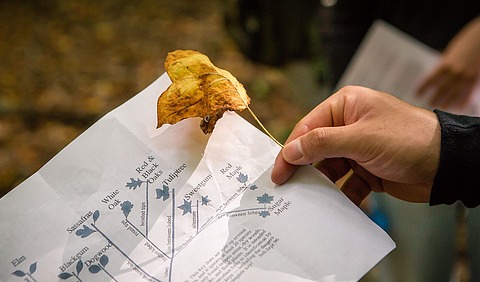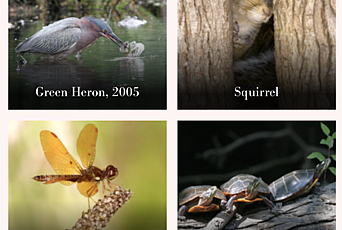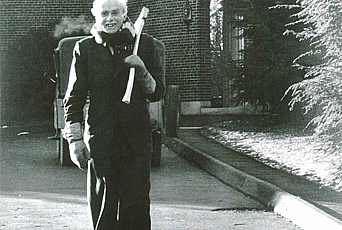The Curriculum of the Woods

As disinclined as we are toward the laboratory setting at the Institute, preferring instead the theoretical realm of pen and paper, we are flanked by one that is 589 acres: the Institute Woods. There, yellow trout lilies and yellow warblers find themselves in an open-air lab made up of bigtooth aspen, black and sweet gum, oak and hickory, gray birch, beech, elm, and red maple trees. In fall, a migration happens: flocks of undergraduates, like birds on the Atlantic Flyway, arrive from Princeton University in order to conduct a field laboratory exercise in forest succession, one that was hatched in the Woods almost 50 years ago.

Due to the fact that a portion of these lands have never been farmed or logged, with the rest of the acreage in recovery from human disturbance dating back between 80 and 200 years, the Woods, preserved by the Institute for Advanced Study, provides a mixed landscape perfect for studies in the succession of trees. Henry Horn, the founding director of Princeton’s Program in Environmental Studies and celebrated naturalist, used it for exactly this reason when he outlined his predictive model for the stages of forest regeneration in 1975. Published in Scientific American, “Forest Succession” is now a fixture in the introductory curriculum of Professor Jonathan Levine, Chair of Princeton’s Department of Ecology & Evolutionary Biology. The simplicity of Horn’s mathematical method allows students to predict thousands of years of forest growth with just an afternoon of fieldwork and a simple calculator: “My laboratory fits into a carpenter’s apron,” Horn notes.
The activity has students first take a survey of the prevalence of different tree species in the Woods. Next, they observe the tree canopies and their driplines to determine what saplings are found in the vicinity and their quantity. With this data, they start to see what species might replace the current trees. For example, if fifty percent of saplings underneath a beech tree are white oak and a smaller proportion are beech saplings, it is reasonable to predict the abundance of white oak will trend upwards while beech trends downward, the former replacing the latter. Students are then able to take this data and build a matrix of transitions between tree species. Simple multiplication can subsequently propel these predictions into far flung futures: by multiplying the transition matrix of the forest by the vector of tree species abundances, a picture of succession is generated, one that you can use to fast forward thousands of years.
Understandably, these predictions are imperfect. An afternoon’s worth of work does not a forest foretell. There are far too many variables and assumptions that make this picture of succession incomplete. But it is this deficiency that proves to be an important pedagogical tool. It allows the students to ask themselves, why isn’t this accurate? What can we change or add to improve the result? In that pursuit, the matrix can be further refined and weighted to take into consideration things like the longevity of different species, changes in the climate, the assemblages of plants and animals and their influence on the soil, susceptibility to insects, and the effects of light on trees with different distributions of leaves. These are the kind of variables that more sophisticated models of forest dynamics incorporate, engendering more exact results.

Modeling complex behavior like this is something Institute scholars are familiar with: discussions of dynamical systems are commonplace here, albeit usually not of the arboreous variety. For instance, the Newtonian three-body problem, which tackles the chaotic motion of three massive objects interacting with one another, is a famous problem in dynamics that occupies a number of our Members. A sturdy solution, which currently no one has offered, may be applied to problems of interplanetary space travel.
Forest dynamics, of which forest succession is a major part, can help us with similarly astonishing problems such as climate change. By understanding how forests change, we can understand how best to conserve them. Horn himself makes an argument for this in his paper. Using his findings, he claims that a forest in a state of stasis is not necessarily optimal for its conservation. Successions are paramount. Beech is replaced by oak. A migrating bird seeks a new nest. A laboratory discovers novel tools. But how do these things move forward, and at the same time have preservation in their design?
Take another example found here at the Institute, though in Fuld Hall instead of the Woods: John von Neumann’s Electronic Computer Project—which, due to the Institute’s lack of laboratory facilities, was housed in the basement—marked one of the most successful experiments in early computing. This achievement in computer science, a field which has transformed our world, also gave birth to the first major models of our climate. The nature of this project, with its successions from general-purpose algorithms to climate science, was dynamic enough to invite unexpected discoveries. While a laboratory project like this, which broke away from the theoretical, was controversial at the Institute, it partook of the Institute’s most cherished mission—that of scholarly breakthrough.
It is this ecosystem of discovery that the students strutting through the Woods this fall, who utilize a method inspired and developed on the trails which our earliest Faculty blazed, embody and embolden. Thankfully we have this place, which inspires clear and curious thought, in our backyard, and can continue to learn from it.


